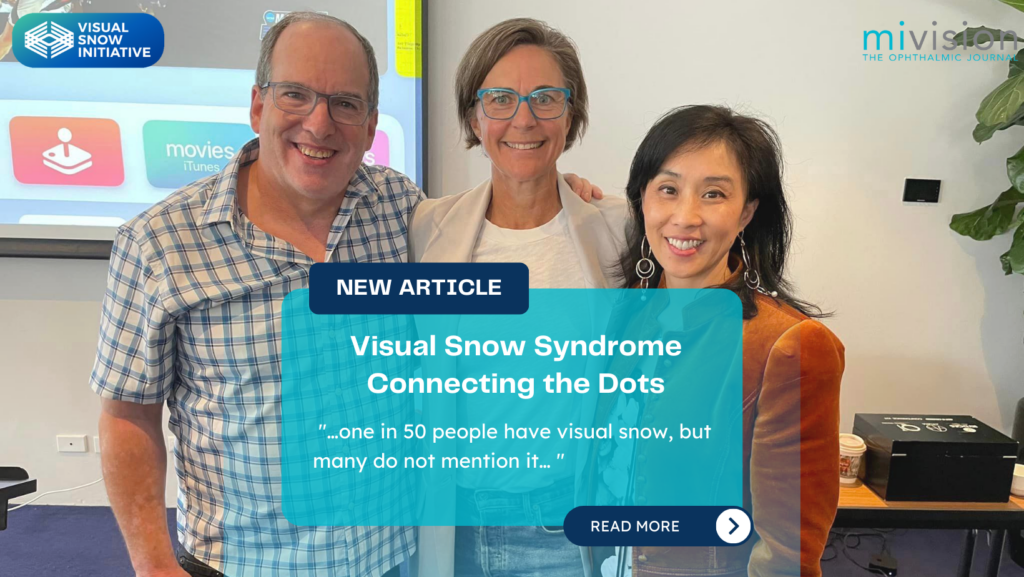ACBO President Melissa Allen
People with visual snow syndrome constantly see the world though black and white or coloured dots. Having encountered a patient with this syndrome in her practice, optometrist Clare Campitelli attended the Australasian College of Behavioural Optometrists’ (ACBO’s) Visual Snow Syndrome conference in Sydney recently to find out more about it.
My first encounter with visual snow was in the pre-COVID era before we knew what a lockdown was – somewhere around March 2020. I remember a young high school patient who was visually irritated to the point of incapacitation by this phenomenon that he called visual snow. A type of visual static was constantly cluttering his visual experience, interfering with easy and comfortable visual processing. I wasn’t able to help resolve his symptoms at that time – it was frustrating for him and for me.

What is Visual Snow?
The accepted diagnostic criteria for visual snow state that the black and white or coloured dots a patient sees must have been persisting for more than three months.
Additionally, the patient must have at least two of the following four conditions:
1. Palinopsia (persistent recurrence of a visual image and/or trailing images after the stimulus has been removed),
2. Enhanced entoptic phenomena,
3. Photophobia (sensitivity or intolerance to light, which can cause some people to avoid sunlight, computers, fluorescent lights, and car headlights), and/or
4. Nyctalopia (impaired night vision).
Additionally, the patient’s symptoms will not be consistent with typical migraine visual aura and cannot be better accounted for by another disorder.
Prevalence
It is estimated that one in 50 people have visual snow, but many do not mention it – either because they were born with the condition, or they have learned to live with it. However, for many people, particularly when the syndrome is acquired due to stress, brain injury, or a health condition, visual snow can severely impair the ability to work and enjoy a normal life.
The Visual Snow Syndrome conference brought optometrists together to hear from international visual snow experts Dr Charles Shidlofsky and Dr Terry Tsang.
Dr Shidlofsky who practises optometry in Texas, and Dr Tsang who has a clinic in California, described their first visual snow patients similarly. Both patients had seen many expert doctors and eurologists, had endured brain scans with CTs and MRIs, but had found no understanding, no explanation, no relief, no treatment, or hope. The common message they were given was: “There is nothing we can find wrong with your brain; your eyes look normal and healthy; we have no treatment for you.”
Echoing this sentiment, one apposite catch phrase from the weekend was that when looking for evidence of visual snow on MRI or CT scans, “It’s like we’re looking from an airplane 7,000 feet in the air rather than from down on the ground with a magnifying glass”.
Drs Shidlofsky and Tsang have extensive experience using lenses and vision therapy to rehabilitate visual systems compromised by mild brain injury, such as concussion or whiplash. They applied the approach taken to treat these patients to their first visual snow patients with promising results.
In 2018, visual snow patient Sierra Domb and her family launched the Visual Snow Initiative , a resource for patients who are looking for care for their visual snow and to direct research. You can access her TED talk, What is Visual Snow? Transforming Anguish into Action.
Transforming Anguish Into Action
With the help of the Visual Snow Initiative, Drs Shidlofsky and Tsang collaborated on a pilot study, the results of which were published in Frontiers of Neurology in December 2022.
The results from this study, The efficacy of neuro-optometric visual rehabilitation therapy in patients with visual snow syndrome, formed the basis of the ACBO conference.
As the results were discussed, Drs Shidlofsky and Tsang shed light on the questions: what is visual snow, and how do we help people with this syndrome?
Read More Here


